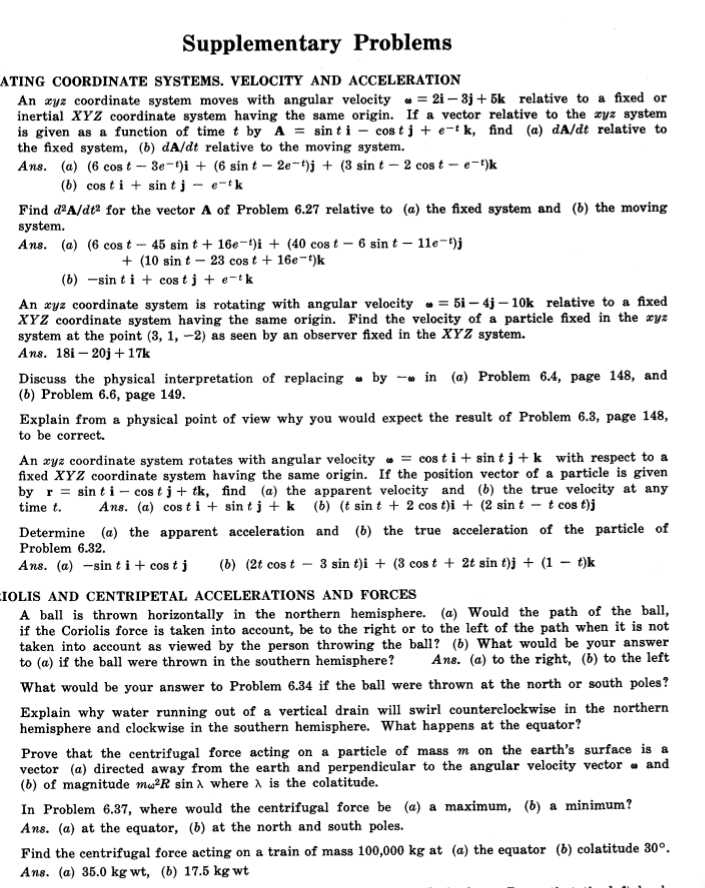
Supplementary Problems ATING COORDINATE SYSTEMS. VELOCITY AND ACCELERATION An xyz coordinate system moves with angular velocity .= 2i - 8j + 5k relative to a fixed or inertial XYZ coordinate system having the same origin. If a vector relative to the wyz system is given as a function of time t by A = sin ti - cost j + e-tk, find (a) dA/dt relative to the fixed system, (b) dA/dt relative to the moving system. Ans. (a) (6 cost - 3e-)i + (6 sint - 2e-t)j + (3 sin t - 2 cost-e-t)k (b) cost i + sin tj - e-tk Find d2A/dt for the vector A of Problem 6.27 relative to (a) the fixed system and (b) the moving system. Ans.(a) (6 cost - 45 sin t + 16e-4)i + (40 cost - 6 sint - 11e-6j + (10 sin t - 23 cost + 16e-t)k (6) -sin ti + costj + e-tk An xyz coordinate system is rotating with angular velocity .= 5i - 4j - 10k relative to a fixed XYZ coordinate system having the same origin. Find the velocity of a particle fixed in the xyz system at the point (3, 1, -2) as seen by an observer fixed in the XYZ system. Ans. 181 - 20j + 17k Discuss the physical interpretation of replacing - by -- in (a) Problem 6.4, page 148, and (b) Problem 6.6, page 149. Explain from a physical point of view why you would expect the result of Problem 6.3, page 148, to be correct. An xyz coordinate system rotates with angular velocity .= cost i + sin tj + k with respect to a fixed XYZ coordinate system having the same origin. If the position vector of a particle is given by r = sin ti - cost j + tk, find (a) the apparent velocity and (b) the true velocity at any time t. Ans. (a) cost i + sint j + k (b) (t sin t + 2 cos t)i + (2 sint -t cost)j Determine (a) the apparent acceleration and (b) the true acceleration of the particle of Problem 6.32. Ans. (a) -sin t i + cos tj (6) (2t cost 3 sin t)i + (3 cost + 2t sin t)j + (1 – t)k FIOLIS AND CENTRIPETAL ACCELERATIONS AND FORCES A ball is thrown horizontally in the northern hemisphere. (a) Would the path of the ball, if the Coriolis force is taken into account, be to the right or to the left of the path when it is not taken into account as viewed by the person throwing the ball? (b) What would be your answer to (a) if the ball were thrown in the southern hemisphere? Ans. (a) to the right, (b) to the left What would be your answer to Problem 6.34 if the ball were thrown at the north or south poles ? Explain why water running out of a vertical drain will swirl counterclockwise in the northern hemisphere and clockwise in the southern hemisphere. What happens at the equator? Prove that the centrifugal force acting on a particle of mass m on the earth's surface is a vector (a) directed away from the earth and perpendicular to the angular velocity vector and (b) of magnitude mw R sin , where is the colatitude. In Problem 6.37, where would the centrifugal force be (a) a maximum, (b) a minimum? Ans. (a) at the equator, (b) at the north and south poles. Find the centrifugal force acting on a train of mass 100,000 kg at (a) the equator (b) colatitude 30º. Ans. (a) 35.0 kg wt, (b) 17.5 kg wt
没有找到相关结果